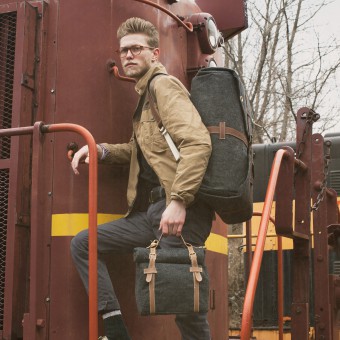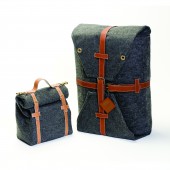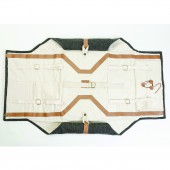
| THE AWARD |
| CATEGORIES |
| REGISTRATION |
| SUBMIT YOUR WORK |
| ENTRY INSTRUCTIONS |
| TERMS & CONDITIONS |
| PUBLICATIONS |
| DATES & FEES |
| METHODOLOGY |
| CONTACT |
| WINNERS |
| PRESS ROOM |
| GET INVOLVED |
| DESIGN PRIZE |
| DESIGN STORE |
| THE AWARD | JURY | CATEGORIES | REGISTRATION | PRESS | WINNERS | PUBLICATIONS | ENTRY INSTRUCTIONS |
Errant and Cheval Adaptable Luggage by Guillermo Fok De Jesus |
Home > Winners > Design #68550 >Interview |
 |
|
FS: What is the main principle, idea and inspiration behind your design?
GF: I wanted to offer a simple and holistic solution to short term traveling, inspired by the industrial revolution and newly mainstream train traveling, I used materials and shapes to evoke a vintage feel and provide modern day functionality.
FS: What has been your main focus in designing this work? Especially what did you want to achieve?
GF: I wanted to create something simple, analog and heavily inspired by my historic research. I wanted to evoke a specific feel through materials, textures and form while providing an innovative solution to the travel experience.
FS: What are your future plans for this award winning design?
GF: I continue to develop ideas stemming from this design, thinking of different scenarios and alternative solutions that follow a similar aesthetic but incorporate new materials and functionality.
FS: How long did it take you to design this particular concept?
GF: from beginning to end approximately 8 months
FS: Why did you design this particular concept? Was this design commissioned or did you decide to pursuit an inspiration?
GF: IT was born as a graduate thesis and it evolved from that into a passion of mine after i graduated
FS: Is your design being produced or used by another company, or do you plan to sell or lease the production rights or do you intent to produce your work yourself?
GF: I am currently looking at a made to order business model, where I would personally work with individual users/ clients to create bespoke solutions based on my designs.
FS: What made you design this particular type of work?
GF: I was interested in diving into travel and traveling accessories. I didn't quite know where this would lead me to but early on I became fascinated by luggage and the evolution of luggage based on how leisure travel changed with technological advances throughout the decades.
FS: Where there any other designs and/or designers that helped the influence the design of your work?
GF: Primarily historical luggage pieces, specifically steamer trunks and carpet bags used during the first few decades of the 20th century
FS: Who is the target customer for his design?
GF: weekend travelers, people who like to travel light and enjoy being on the move
FS: What sets this design apart from other similar or resembling concepts?
GF: It offers a practical and efficient solution to packing / unpacking in a simple but effective way. It looks to evoke a specific feeling through materials , textures and form to create a holistic experience.
FS: How did you come up with the name for this design? What does it mean?
GF: It came from the research portion of it. This is a travel set comprised of two items. Errant was inspired by knights errant, people wandering in search of adventure and Cheval (horse in french) came after, being the sole companion to a knight during his quests.
FS: Which design tools did you use when you were working on this project?
GF: it was a very hands on process, lots of prototypes were done before the final product. Most of it was done with a Sewing machine and the leather work was done by hand.
FS: What is the most unique aspect of your design?
GF: Finding new functionality in a unique and simple way
FS: Who did you collaborate with for this design? Did you work with people with technical / specialized skills?
GF: I had a huge help from the faculty at my grad school. A key figure was one of my mentors Professor Melissa Dawson, who helped me understand textile construction and properties as well as sewing.
FS: What is the role of technology in this particular design?
GF: I think for this particular design i was looking to stay as analog as possible. I wanted to be able to offer something new with "traditional" construction methods.
FS: Is your design influenced by data or analytical research in any way? What kind of research did you conduct for making this design?
GF: It was mostly historical research. Analytical data was conducted to target user needs but the majority of it was focused in understanding the evolution of travel accessories over the last 100 years
FS: What are some of the challenges you faced during the design/realization of your concept?
GF: Understanding new materials and how different qualities could complement each other. Understanding strength and weaknesses of materials and construction methods to create something that would be efficient, durable and offer a new take on traveling.
FS: How did you decide to submit your design to an international design competition?
GF: I always had a great passion for this project and the concepts that came after it. i was inspired by a few of my colleagues who submitted projects to this competitions in prior years and decided to give it a try.
FS: What did you learn or how did you improve yourself during the designing of this work?
GF: I learned to always be open to working with new materials an techniques. There's always a challenge but a bigger reward when working with new processes, and it definitely had a big impact in the outcome of this project.
FS: Thank you for providing us with this opportunity to interview you.
A' Design Award and Competitions grants rights to press members and bloggers to use parts of this interview. This interview is provided as it is; DesignPRWire and A' Design Award and Competitions cannot be held responsible for the answers given by participating designers.
| SOCIAL |
| + Add to Likes / Favorites | Send to My Email | Comment | View Press-Release |




